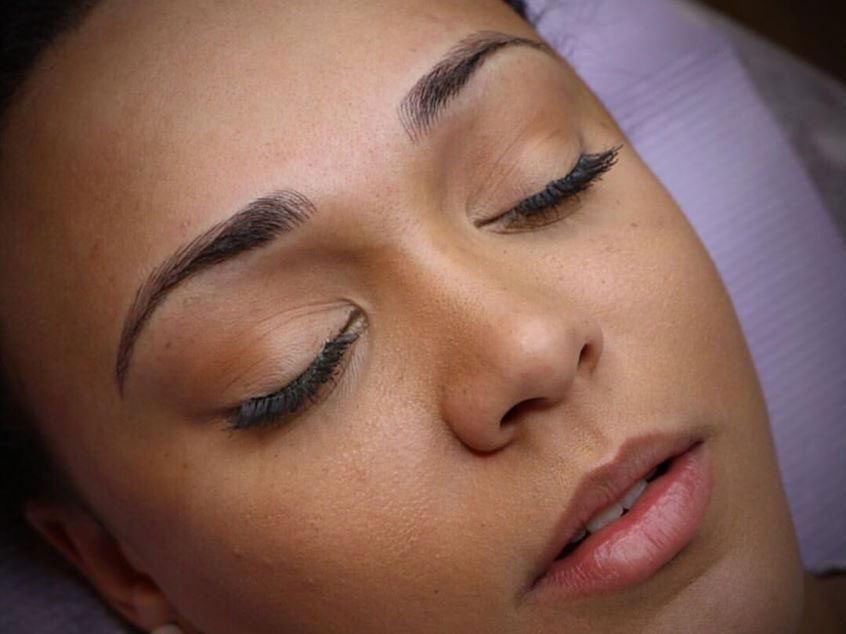Microblading 101: Everything You Need to Know About Permanent Brows
 Everyone's got their no-makeup comfort zones, whether it's leaving the house sporting a bare face with just a bold lip or wearing a fully-done face. But if there's one thing we've learned from the pros, well-defined eyes and brows can be the key to stepping out sans makeup in confidence when you're too time-pressed to whip up a full look.
Everyone's got their no-makeup comfort zones, whether it's leaving the house sporting a bare face with just a bold lip or wearing a fully-done face. But if there's one thing we've learned from the pros, well-defined eyes and brows can be the key to stepping out sans makeup in confidence when you're too time-pressed to whip up a full look.
Enter microblading, a permanent brow enhancement technique that's been getting steady mainstream attention. It's a form of brow tattooing that results in more natural-looking results than traditional methods, says award-winning microblading artist and Microblading LA founder Linsday Ta.
"It’s a much different technique of how we perform it," Ta tells us. "We’re not using a machine, we’re using a handtool and freehand drawing each hairstroke with a tool that has a microblade."
After a personal consultation to determine right shape and color, the artist then uses a waterproof brow pencil to draw the brows. Once the client approves, the microblading process begins with the application of a topical anesthetic. Then, a microblade is used to "draw" individual hairstrokes and permanent brow ink is applied. When the microblading artist is finished, the excess ink is wiped off to reveal the final result.
A touch-up appointment is required 30 days after the initial session; by then, the skin is usually healed and the color has settled in. Since every client's skin tone and type is different, the microblading artist will use the second sesh to make any needed corrections.
"Here at Microblading LA, we book two hours (for the first session)," Ta says. "Most of the time is the consultation and the numbing, which is about one hour total. The actual procedure is a half hour to 45 minutes at most." Pricing varies by studio; Microblading LA's services are $700 (which includes a complimentary touch-up within 8 weeks) and $200 to $500 for subsequent touch-ups.
The Los Angeles brow studio — which has boosted the eyebrows of stars like Bella Thorne and Kathy Griffith — recommends that people who should avoid microblading include pregnant or breastfeeding women, those undergoing chemotherapy, those with HIV or other transmittable blood diseases, or anyone with sensitive skin issues like post-inflammatory hyperpigmentation, to name just a few.
Read on below to find more about the permanent brow-boosting technique, what recovery time is like, how to find a trust-worthy microblading artist, and more.
Are there different microblading methods for certain brow goals or concerns?
"Generally it’s the same method: skin has to be stretched, ink goes into the skin, microblading is done with a specific tool and blade; there’s nothing optional about that. But there’s different patterns that artists call 'hairstroke mapping.'
One artist can have completely different mapping that no one has seen before. When you’re learning, you always have an academy or trainer that teaches you a specific mapping method — but it’s all mimicking natural hair growth."
What do microblading artists consider when working on a client?
"From the client’s perspective, they usually see color and shape. From an artist’s perspective, there’s different needle configurations, there’s how we draw out each hairstroke, how we are placing them, how much color retention is in each hairstroke, how consistent is the work. That’s what we see as an artist."
What’s the recovery time like, and how should people care for their new brows immediately after the procedure?
"Generally, the first week is dramatic because the color is darker, everything looks bolder, the skin might be red if they are sensitive. And then there’s scabbing, since we’re cutting the skin and putting ink underneath. Some people have obvious scabbing, some people barely notice it’s there. Everybody scabs. The most dramatic stage is the first 10 days. After that, you can wear makeup and wash your face like normal.
Immediately after, the best after care is to leave them alone. Keep them clean, don’t apply anything, don’t wet them, don’t scratch them, don’t sleep on them. Let them do their natural healing. You have to let them breathe and heal.
We always give clients an after care sheet with more detailed instructions."
For those outside of LA who can’t come to your office, what are your top tips for finding a trust-worthy microblading professional?
"You need to see healed work. You need to see their portfolio on their website or Instagram. Find women in their portfolio who look like you, with similar skin texture and skin tone. Even better is a direct referral from someone you see in person.
They should also be licensed by their county, so you know they’re meeting sanitation standards."
Looking for other permanent eyebrow procedures? Check out the episode of The SASS below that's all about brow tattoo makeup:








